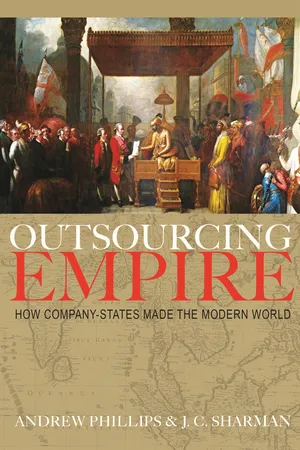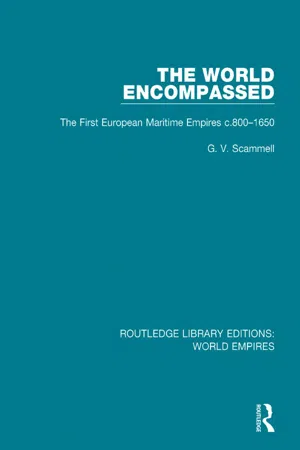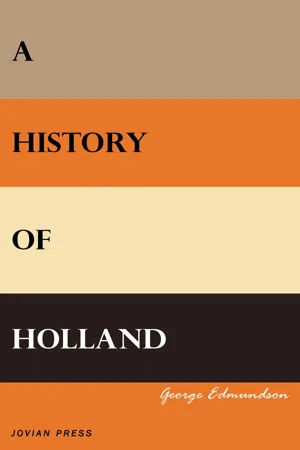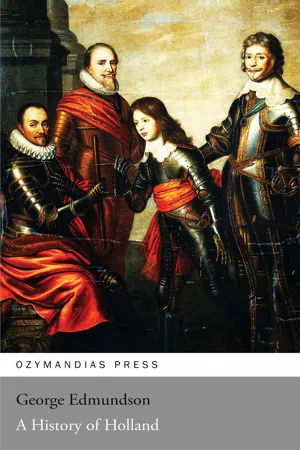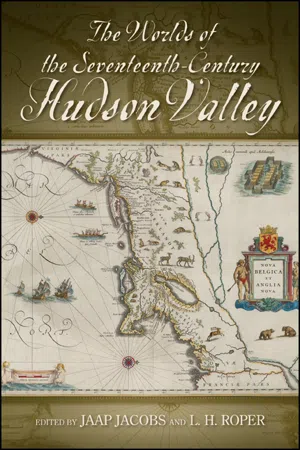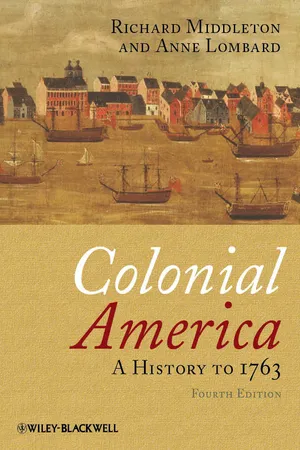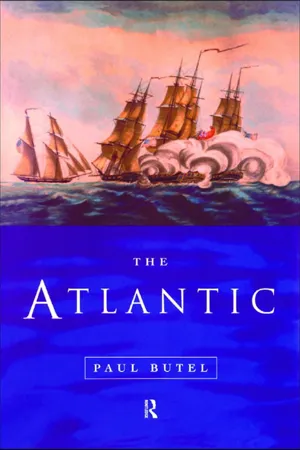History
Dutch West India Company
The Dutch West India Company was a trading company established in 1621 by the Dutch Republic to conduct trade and establish colonies in the Americas and Africa. It played a significant role in the Dutch colonization of the Americas, particularly in the establishment of New Netherland (present-day New York) and the Caribbean. The company also engaged in the transatlantic slave trade.
Written by Perlego with AI-assistance
Related key terms
9 Key excerpts on "Dutch West India Company"
- eBook - ePub
Outsourcing Empire
How Company-States Made the Modern World
- Andrew Phillips, J. C. Sharman(Authors)
- 2020(Publication Date)
- Princeton University Press(Publisher)
The Dutch Moment: War, Trade and Settlement in the Seventeenth Century Atlantic World by Wim Klooster (Cornell University Press, 2016).Nearer the expiration of the truce, shifts in power between Dutch hawks and doves renewed the impetus to open another front against the Habsburgs in the Americas and the Atlantic using the same institutional model as the VOC. Once chartered in 1621 for a term of 24 years, the West India Company set about raising its initial capital of 7.1 million florins, slightly larger than the 6.5 million VOC had begun with, but an order of magnitude greater than the English East India Company, let alone the Royal African or Hudson’s Bay Companies fifty years later.17 Where the VOC had reached its target in a month, however, the newer company took two years. This rather tepid support reflected concerns among investors about the extent to which the new company would pursue piracy and conquest over profits and dividends.18 These concerns were later shown to be well-founded.19Notwithstanding the differences indicated above, the charter otherwise followed the precedent of the VOC in the suite of legal and sovereign powers conferred, including powers to make war and peace, engage in diplomacy, and carry out administrative and judicial roles in the lands it conquered. “Once again, commerce, capital, and state power worked hand in hand to produce another weapon in the struggle for Dutch independence, profit and influence, and once again a company seemed to provide the proper and necessary means.”20 The WIC was granted a monopoly on trade from Newfoundland to the Cape of Good Hope, but also in the Pacific from the west coast of the Americas to New Guinea. Thus trading rights in the whole extra-European world were divided between the two Dutch company-states.21The company was to be run by a board of 19 directors, the Heeren XIX. The distribution of directorships among different chambers reflected both the United Provinces’ confederal structure, but also the financial and political power of Holland and Amsterdam in particular. The latter received eight votes on the board; Zeeland, four; the Northern Quarter, Maas, and Gronigen, two each; while as noted the representative of the States-General held the nineteenth vote. Although Amsterdam was clearly the most powerful, its dominance was somewhat less pronounced than in the VOC, or for that matter the States-General, where Holland provided over 58 percent of the total revenue.22 Despite their formal rights, as with the VOC, the WIC often rode roughshod over the wishes of its shareholders, refusing audits and only reluctantly distributing dividends.23 - eBook - ePub
South Africa
An Historical Introduction
- Freda Troup(Author)
- 2022(Publication Date)
- Routledge(Publisher)
II The Company (1652–1795)1. Dutch East India Company and White Settlement
As Portugal came under Spanish domination in the latter part of the sixteenth century, the Dutch provinces of the north were banding together under the leadership of William of Orange in the struggle to free themselves from Spain’s stranglehold. Lisbon had succeeded Venice as the great European centre of East-West trade and Philip II of Spain, hoping to subdue the rebellious Protestant Netherlands, closed the port of Lisbon to their traders. Undaunted, the Dutch set off themselves for the East and soon challenged the declining Portuguese influence in the Indian Ocean.The Netherlands - the Lowlands - was a low-lying, fertile country, criss-crossed by the channels of the Rhine delta, with an immensely long indented coast line in relation to its size. By the turn of the sixteenth century, the Dutch were an industrious and prosperous people. They were able farmers and capable fishermen and seafarers. Situated on the then trading cross-roads of Europe, they possessed a strong commercial bent and high educational standards - Flemish and Jewish financiers, refugees from persecution in Catholic Spain, made Amsterdam the banking centre of the West. Powerful commercial companies grew up, and as the Dutch provinces united politically so the rival companies abandoned their competition and amalgamated to form the Dutch East India Company, which received its Charter from the government in 1602.The government of the United Provinces held a large share in the Company and many of the leaders of the legislature were directors. It leased to the Company a monopoly of trade and took a cut of the profits. Only Dutchmen were permitted to hold shares, but small investors were encouraged so as to spread interest as widely as possible and to involve a large section of the people in the Company’s commercial fortunes. The direction of policy lay with the governing Council of Seventeen, selected by the States-General from lists submitted by the Estates of the Provinces and subject to review by a Vigilance Committee of eight directors at The Hague. - eBook - ePub
The World Encompassed
The First European Maritime Empires c.800-1650
- G. V. Scammell(Author)
- 2018(Publication Date)
- Routledge(Publisher)
But that imperial success was not the necessary corollary of business acumen, and that merchants could be as ardent in the pursuit of chimera as squires and peasants was shown by the history of the Dutch West India Company (WIC= West Indische Compagnie). This, unlike the VOC, sprang from no existing trading organizations, but was created in 1621 ‘to do all that the service of this country and the profit and increase of trade shall require’. In other words it was to attack Iberian possessions, commerce and shipping in the Atlantic and in so doing both benefit the republic’s merchant oligarchs whilst diverting, at little cost to the state, Spanish strength and resources away from the Low Countries. The better to accomplish these objectives the company was given a twenty-five-year monopoly of Holland’s trade and navigation with the Americas and West Africa, and granted the same semi-sovereign powers as the VOC. It was of a similar federal structure, comprising five ‘chambers’, each entitled to conduct a more or less automonous commerce with some particular area. Like the VOC, the company was dominated by a self-recruiting oligarchy of directors who, however, held office for only six years and accounted to the shareholders at a similar interval. The WIC was financed, as was the East India Company, by the sale of shares on the open market. It attracted money from the same wide range of investors – with serving girls and merchant plutocrats alike contributing to its capital – and was again dominated by Amsterdam and Zeeland. Between them their ‘chambers’ were entitled to two-thirds of the company’s trade, and together they provided twelve out of the WIC’s nineteen-man central management (Heeren- 19). But because of the company’s strategic purpose state direction was closer than with the VOC (cf. pp. 403ff.) - eBook - ePub
- George Edmundson(Author)
- 2017(Publication Date)
- Jovian Press(Publisher)
THE EAST AND WEST INDIA COMPANIES. COMMERCIAL AND ECONOMIC EXPANSION
~AN ACCOUNT OF THE FOUNDATION, constitution and early efforts of the Dutch East India Company has been already given. The date of its charter (March 20, 1602) was later than that of its English rival (Dec. 31, 1600), but in reality the Dutch were the first in the field, as there were several small companies in existence and competing with one another in the decade previous to the granting of the charter, which without extinguishing these companies incorporated them by the name of chambers under a common management, the Council of Seventeen. The four chambers however—Amsterdam, Zeeland, the Maas (Rotterdam and Delft) and the North Quarter (Enkhuizen and Hoorn)—though separately administered and with different spheres, became gradually more and more unified by the growing power of control exercised by the Seventeen. This was partly due to the dominating position of the single Chamber of Amsterdam, which held half the shares and appointed eight members of the council. The erection of such a company, with its monopoly of trade and its great privileges including the right of maintaining fleets and armed forces, of concluding treaties and of erecting forts, was nothing less than the creation of an imperium in imperio; and it may be said to have furnished the model on which all the great chartered companies of later times have been formed. The English East India Company was, by the side of its Dutch contemporary, almost insignificant; with its invested capital of £30,000 it was in no position to struggle successfully against a competitor which started with subscribed funds amounting to £540,000.The conquest of Portugal by Spain had spelt ruin to that unhappy country and to its widespread colonial empire and extensive commerce. Before 1581 Lisbon had been a great centre of the Dutch carrying-trade; and many Netherlanders had taken service in Portuguese vessels and were familiar with the routes both to the East Indies and to Brazil. It was the closing of the port of Lisbon to Dutch vessels that led the enterprising merchants of Amsterdam and Middelburg to look further afield. In the early years of the seventeenth century a large number of expeditions left the Dutch harbours for the Indian Ocean and made great profits; and very large dividends were paid to the shareholders of the company. How far these represented the actual gain it is difficult to discover, for the accounts were kept in different sets of ledgers; and it is strongly suspected that the size of the dividends may, at times when enhanced credit was necessary for the raising of loans, have been to some extent fictitious. For the enterprise, which began as a trading concern, speedily developed into the creation of an empire overseas, and this meant an immense expenditure. - eBook - ePub
- George Edmundson(Author)
- 2018(Publication Date)
- Ozymandias Press(Publisher)
THE EAST AND WEST INDIA COMPANIES. COMMERCIAL AND ECONOMIC EXPANSION
AN ACCOUNT OF THE foundation, constitution and early efforts of the Dutch East India Company has been already given. The date of its charter (March 20, 1602) was later than that of its English rival (Dec. 31, 1600), but in reality the Dutch were the first in the field, as there were several small companies in existence and competing with one another in the decade previous to the granting of the charter, which without extinguishing these companies incorporated them by the name of chambers under a common management, the Council of Seventeen. The four chambers however—Amsterdam, Zeeland, the Maas (Rotterdam and Delft) and the North Quarter (Enkhuizen and Hoorn)—though separately administered and with different spheres, became gradually more and more unified by the growing power of control exercised by the Seventeen. This was partly due to the dominating position of the single Chamber of Amsterdam, which held half the shares and appointed eight members of the council. The erection of such a company, with its monopoly of trade and its great privileges including the right of maintaining fleets and armed forces, of concluding treaties and of erecting forts, was nothing less than the creation of an imperium in imperio; and it may be said to have furnished the model on which all the great chartered companies of later times have been formed. The English East India Company was, by the side of its Dutch contemporary, almost insignificant; with its invested capital of £30,000 it was in no position to struggle successfully against a competitor which started with subscribed funds amounting to £540,000.The conquest of Portugal by Spain had spelt ruin to that unhappy country and to its widespread colonial empire and extensive commerce. Before 1581 Lisbon had been a great centre of the Dutch carrying-trade; and many Netherlanders had taken service in Portuguese vessels and were familiar with the routes both to the East Indies and to Brazil. It was the closing of the port of Lisbon to Dutch vessels that led the enterprising merchants of Amsterdam and Middelburg to look further afield. In the early years of the seventeenth century a large number of expeditions left the Dutch harbours for the Indian Ocean and made great profits; and very large dividends were paid to the shareholders of the company. How far these represented the actual gain it is difficult to discover, for the accounts were kept in different sets of ledgers; and it is strongly suspected that the size of the dividends may, at times when enhanced credit was necessary for the raising of loans, have been to some extent fictitious. For the enterprise, which began as a trading concern, speedily developed into the creation of an empire overseas, and this meant an immense expenditure. - Jaap Jacobs, L. H. Roper, Jaap Jacobs, L. H. Roper(Authors)
- 2014(Publication Date)
- Excelsior Editions(Publisher)
12As the Netherlands mutated into a postcolonial society following World War II, assumptions of European superiority embedded in accounts of the Dutch Empire proved hard to dislodge. Even as native peoples moved toward self-determination, scribes in the fatherland continued to privilege colonizers. The Dutch East Indies, assumed to be the centerpiece of the Dutch colonial empire, remained in the forefront of national thinking, as Indonesian independence failed to subdue nostalgia for the glory days of Dutch East India Company rule. The determination of politicians to preserve Dutch influence in Indonesia, though ill-advised and ultimately unsuccessful, also impeded efforts to rethink the history of Dutch colonialism. One fateful consequence of continuing to dwell on the positive outcomes of Dutch colonization in the East Indies, particularly in the realm of international commerce, was the relegation of the Dutch West India Company’s activities, and specifically its involvement in the transatlantic slave trade, to the margins of national history. Overlooking the evidence of Indian Ocean slavery, keepers of the Dutch past found little incentive to inflect the national narrative with discussion of Dutch slave trading and slave holding.13It was not until streams of immigrants from the former Dutch colonies in the West Indies altered the makeup of the Netherlands’ population in the final decades of the twentieth century that the inattentiveness to Dutch slaving enterprises began to be remedied. Pressure from Caribbean activists, particularly immigrants from Surinam, to weave enslaved Africans into the narrative of national history accelerated the efforts of Dutch academics to bring greater recognition to the Dutch role in the slave trade and slavery. Another strand of research concerning the lack of Dutch participation in the antislavery movement added further layers of proof to the increasingly somber picture of Dutch colonialism and its aftermath.14- eBook - ePub
Colonial America
A History to 1763
- Richard Middleton, Anne Lombard(Authors)
- 2011(Publication Date)
- Wiley-Blackwell(Publisher)
When it appeared in 1620 that war was about to break out again between Spain and Holland, Dutch interest in the area revived, in part because a base might be required for operations across the Atlantic. The Dutch East India Company was preoccupied elsewhere so a new corporation was formed to establish a base and exploit the area's commercial potential. Initially, the Dutch West India Company devoted its attention to Bahia in the Caribbean, until a small group of settlers was finally dispatched to the mainland of North America to consolidate Dutch claims to the region in 1624. Most of the party went to the site of the earlier post, now called Fort Orange, to resume the fur trade. A smaller group settled on Governor's Island at the mouth of the Hudson, while a further detachment went to the Delaware Valley, establishing Fort Nassau near the future city of Philadelphia. To guard against the possibility of attack by competing European powers, additional settlers were sent in 1625 to a fortified post on Manhattan Island called New Amsterdam.In some respects the Dutch company resembled that of Virginia in its early stages. Governmental authority lay primarily with the director general and his officials, though they were supposed to seek the occasional advice of a council drawn from the inhabitants. Most settlers arrived as servants of the company, usually for a period of six years. After this they could take up tenancies, as in Virginia. In other respects, the Dutch company's policies were quite different from those of the Virginia Company. Dutch colonists were required only to grow food, and to sell their produce to the company. The company offered few incentives to encourage immigration. Thus, though the settlement never experienced the tribulations of Virginia, since it was self-sufficient from the outset, it grew very slowly, like the colony of New France. By 1630 it contained only 300 inhabitants.Historians have sometimes portrayed the Dutch failure to encourage immigration into New Netherland as evidence of Dutch short-sightedness, a failure to envision the profit-making potential of an expanding agricultural colony. But recent research suggests the Dutch West India Company made a conscious, even principled decision to focus primarily on trade rather than on settlement. According to this view, the Dutch sought a colony that remained “alongshore,” on the margins of Native American society, rather than one that pressed into the interior.5 Their rights to inhabit the land would be based on contractual relationships with the native inhabitants rather than on conquest or the grants of a distant monarch. Consistent with these principles, the company initially developed policies to help it build amicable trading relationships and to avoid hostilities with the local Indians. Policy dictated that land should be purchased from the Indians, not taken by force. When Willem Verhulst and his successor Peter Minuit negotiated an alliance and purchased the island from the Manhattan Indians6 - eBook - ePub
A Beautiful and Fruitful Place
Selected Rensselaerwijck Papers, Volume 2
- Elisabeth Paling Funk, Martha Dickinson Shattuck, Elisabeth Paling Funk, Martha Dickinson Shattuck(Authors)
- 2011(Publication Date)
- Excelsior Editions(Publisher)
propriétaires, who had been operating independently of government control, and by appointing governors tied to Paris, the colonies were subordinated to the crown. At least for the time being, the winds of change that had been blowing through the New World had dropped.Passage contains an image A Monopoly Relinquished
THE WEST INDIA COMPANY AND THE ATLANTIC SLAVE TRADEJOH . POSTMAThe Dutch West India Company (WIC) was inextricably connected with the Atlantic slave trade. One can hardly be discussed without reference to the other. The Company was by far the most important Dutch commercial instrument in the transport of slaves from Africa to the Americas. For more than a century, the WIC had monopoly control over the Dutch slave trade, and during the last quarter of the seventeenth century, it was undoubtedly the largest slaving establishment in the Atlantic. WIC ships carried approximately 285,000 slaves to the New World, nearly 60 percent of the approximately half a million slaves shipped from Africa by Dutch carriers.1Despite the prominence of the WIC in the slave traffic, the Company was not established for dealing in slaves. In fact, the founders of the company initially rejected participation in that traffic because the profitability of shipping slaves from Africa had not yet been recognized in 1621, the year the WIC was founded. At the initial meetings of the Company's directors, a majority was hesitant to engage in the slave trade, and they prevailed on the rest to consider its moral implications by consulting Calvinist theologians. The latter condoned slavery as a legitimate institution but cast doubt on the moral rectitude of trading in human beings. Thus, the directors decided not to make the slave trade one of the standard activities of the WIC.2 - eBook - ePub
- Paul Butel, Iain Hamilton(Authors)
- 2002(Publication Date)
- Routledge(Publisher)
In the face of these difficulties, overseas expansion made a striking contrast both in the New World and in Asia. The Dutch entertained great hopes and thought it possible that the Spanish and Portuguese Indies might be broken up. In the event, however, at least in the Americas, the expansion proved difficult, perhaps because of the late foundation of the West Indies Company, which was only created when the truce ended in 1621, more than 15 years after the initial project. Moreover, due to the resistance of Fresian ports such as Hoorn, which dominated the salt trade in the Caribbean and had no wish for a monopoly, it was only ready to act in 1623.To attract shareholders, the company directors presented the general malaise of which Dutch trade was the victim in Europe’s seas. The trade in Baltic grain had just collapsed there, and Madrid’s embargoes reduced its shipments. They contrasted this with all the benefits of a colonial trade based on closely defended trading posts and plantations, which would give stability to commerce by expanding Dutch markets.This propaganda was only partially successful, and the share subscription for the company was rather slow in taking off. The largest investors were a few merchants who had played a major role in the first expansion in the Caribbean, in Brazil and Guinea: Bartholotti put in up to 100,000 florins, while Balthasar Coymans risked 20,000—both men belonged to a group of merchants who were immigrants in Antwerp and who gave new vigour to Dutch trade. The Regents’ oligarchy emerged as the most favoured, without however being able to claim to monopolize investment, or even manage it. In particular, Amsterdam’s share was not very high in relation to the town’s importance, making a total of 1,700,000 florins from a share issue greater than 6,600,000. It was in certain towns in the interior, far from the sea, where religious and political zealotry fuelled heightened efforts in the war against Spain (the company had also to be an instrument of aggression against the Iberians), that the most active participation could be found. Leiden and Utrecht contributed 270,000 and 215,000 florins, Groningen 400,000.
Index pages curate the most relevant extracts from our library of academic textbooks. They’ve been created using an in-house natural language model (NLM), each adding context and meaning to key research topics.
